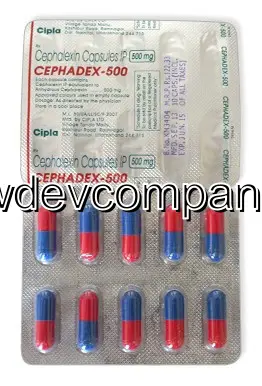Buy Cephalexin Online — Fast US Delivery
| Package | Dosage | Price | Price per Dose | |
|---|---|---|---|---|
| Dosage: 500mg | ||||
| 270 pill | 500mg | $739.68 | $2.74 | |
| 180 pill | 500mg | $502.48 | $2.79 | |
| 120 pill | 500mg | $351.38 | $2.93 | |
| 90 pill | 500mg | $277.59 | $3.07 | |
| 60 pill | 500mg | $198.52 | $3.30 | |
| 30 pill | 500mg | $112.43 | $3.76 | |

Cephalexin Description
Introduction to Cephalexin
Cephalexin is a widely used antibiotic medication belonging to the class of cephalosporins. It is commonly prescribed to treat a variety of bacterial infections, including respiratory tract infections, skin infections, ear infections, and urinary tract infections. The drug is known for its effectiveness against many bacteria that are sensitive to beta-lactam antibiotics.
How Cephalexin Works
This medication works by inhibiting the synthesis of the bacterial cell wall. It binds to specific proteins called penicillin-binding proteins (PBPs) located inside the bacterial cell wall. This interference weakens the cell wall, leading to the destruction of the bacteria through a process called bacteriolysis. Since humans do not have cell walls, Cephalexin selectively targets bacteria without damaging human cells.
Usage and Dosage
Cephalexin is usually taken orally in the form of capsules or tablets. The dosage depends on the severity of the infection, the patient’s age, weight, and renal function. Generally, it is prescribed for 7 to 14 days. It’s important to complete the full course of therapy, even if symptoms improve before finishing the medication, to prevent resistance development and ensure the infection is fully eradicated.
Advantages of Cephalexin
One of the key benefits of Cephalexin is its broad spectrum of activity against Gram-positive bacteria. It is well tolerated by most patients, with minimal side effects reported. The medication’s oral formulation makes it convenient for outpatient treatment and improves patient compliance. Additionally, it tends to have fewer drug interactions compared to some other antibiotics.
Possible Side Effects and Precautions
Although generally safe, Cephalexin can cause side effects in some individuals. Common adverse reactions include gastrointestinal disturbances such as nausea, diarrhea, or vomiting. Allergic reactions, although rare, can be more serious and include rash, swelling, or difficulty breathing. Patients with a history of allergies to penicillins or cephalosporins should inform their healthcare provider before starting treatment.
Considerations and Interactions
Patients with kidney impairment may require dose adjustments to prevent toxicity. It’s also important to inform healthcare providers of any other medications being taken, as Cephalexin can interact with certain drugs such as nephrotoxic agents or probenecid. Alcohol consumption should be avoided during therapy to reduce gastrointestinal discomfort and possible interactions.
Effectiveness and Resistance
Cephalexin remains a reliable choice for many bacterial infections; however, antibiotic resistance can develop if it is overused or misused. Some bacteria have acquired resistance mechanisms, rendering Cephalexin ineffective. Therefore, testing for bacterial sensitivity and proper diagnosis are crucial for optimal treatment outcomes.
Conclusion
Overall, Cephalexin is a versatile and effective antibiotic when used appropriately. Its ease of administration and favorable safety profile make it a popular option for treating a range of bacterial infections. Still, responsible use and close consultation with a healthcare provider are essential to ensure its continued efficacy and minimize resistance risks.


